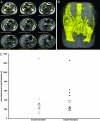The role of skeletal muscle insulin resistance in the pathogenesis of the metabolic syndrome
- PMID: 17640906
- PMCID: PMC1924794
- DOI: 10.1073/pnas.0705408104
The role of skeletal muscle insulin resistance in the pathogenesis of the metabolic syndrome
Abstract
We examined the hypothesis that insulin resistance in skeletal muscle promotes the development of atherogenic dyslipidemia, associated with the metabolic syndrome, by altering the distribution pattern of postprandial energy storage. Following ingestion of two high carbohydrate mixed meals, net muscle glycogen synthesis was reduced by approximately 60% in young, lean, insulin-resistant subjects compared with a similar cohort of age-weight-body mass index-activity-matched, insulin-sensitive, control subjects. In contrast, hepatic de novo lipogenesis and hepatic triglyceride synthesis were both increased by >2-fold in the insulin-resistant subjects. These changes were associated with a 60% increase in plasma triglyceride concentrations and an approximately 20% reduction in plasma high-density lipoprotein concentrations but no differences in plasma concentrations of TNF-alpha, IL-6, adiponectin, resistin, retinol binding protein-4, or intraabdominal fat volume. These data demonstrate that insulin resistance in skeletal muscle, due to decreased muscle glycogen synthesis, can promote atherogenic dyslipidemia by changing the pattern of ingested carbohydrate away from skeletal muscle glycogen synthesis into hepatic de novo lipogenesis, resulting in an increase in plasma triglyceride concentrations and a reduction in plasma high-density lipoprotein concentrations. Furthermore, insulin resistance in these subjects was independent of changes in the plasma concentrations of TNF-alpha, IL-6, high-molecular-weight adiponectin, resistin, retinol binding protein-4, or intraabdominal obesity, suggesting that these factors do not play a primary role in causing insulin resistance in the early stages of the metabolic syndrome.
Conflict of interest statement
Conflict of interest statement: B.B.K. has a research grant from Takeda Pharmaceuticals and is an inventor on a patent for RBP-4.
Figures





Similar articles
-
Reversal of muscle insulin resistance with exercise reduces postprandial hepatic de novo lipogenesis in insulin resistant individuals.Proc Natl Acad Sci U S A. 2011 Aug 16;108(33):13705-9. doi: 10.1073/pnas.1110105108. Epub 2011 Aug 1. Proc Natl Acad Sci U S A. 2011. PMID: 21808028 Free PMC article. Clinical Trial.
-
Skeletal muscle insulin resistance promotes increased hepatic de novo lipogenesis, hyperlipidemia, and hepatic steatosis in the elderly.Diabetes. 2012 Nov;61(11):2711-7. doi: 10.2337/db12-0206. Epub 2012 Jul 24. Diabetes. 2012. PMID: 22829450 Free PMC article.
-
The role of muscle insulin resistance in the pathogenesis of atherogenic dyslipidemia and nonalcoholic fatty liver disease associated with the metabolic syndrome.Annu Rev Nutr. 2010 Aug 21;30:273-90. doi: 10.1146/annurev.nutr.012809.104726. Annu Rev Nutr. 2010. PMID: 20645852 Free PMC article. Review.
-
Metabolism and insulin signaling in common metabolic disorders and inherited insulin resistance.Dan Med J. 2014 Jul;61(7):B4890. Dan Med J. 2014. PMID: 25123125 Review.
-
Fenofibrate reduces systemic inflammation markers independent of its effects on lipid and glucose metabolism in patients with the metabolic syndrome.J Clin Endocrinol Metab. 2010 Feb;95(2):829-36. doi: 10.1210/jc.2009-1487. Epub 2010 Jan 8. J Clin Endocrinol Metab. 2010. PMID: 20061429 Free PMC article. Clinical Trial.
Cited by
-
Structure and function of human xylulokinase, an enzyme with important roles in carbohydrate metabolism.J Biol Chem. 2013 Jan 18;288(3):1643-52. doi: 10.1074/jbc.M112.427997. Epub 2012 Nov 23. J Biol Chem. 2013. PMID: 23179721 Free PMC article.
-
Obesity as an Early Symptom of the AMIS Syndrome.J Clin Med. 2014 Oct 28;3(4):1178-98. doi: 10.3390/jcm3041178. J Clin Med. 2014. PMID: 26237598 Free PMC article. Review.
-
Unlocking the Potential of Type 2 Diabetes Mellitus Remission.Cureus. 2023 Nov 12;15(11):e48704. doi: 10.7759/cureus.48704. eCollection 2023 Nov. Cureus. 2023. PMID: 38094528 Free PMC article. Review.
-
Dyslipidemia: Obese or Not Obese-That Is Not the Question.Curr Obes Rep. 2016 Dec;5(4):405-412. doi: 10.1007/s13679-016-0232-9. Curr Obes Rep. 2016. PMID: 27687811 Review.
-
Drivers of cardiovascular disease in metabolic dysfunction-associated steatotic liver disease: the threats of oxidative stress.Front Cardiovasc Med. 2024 Oct 1;11:1469492. doi: 10.3389/fcvm.2024.1469492. eCollection 2024. Front Cardiovasc Med. 2024. PMID: 39411175 Free PMC article. Review.
References
-
- Reaven GM. Diabetes. 1988;37:1595–1607. - PubMed
-
- Grundy SM, Brewer HB, Jr, Cleeman JI, Smith SC, Jr, Lenfant C. Circulation. 2004;109:433–438. - PubMed
-
- Previs SF, Hazey JW, Diraison F, Beylot M, David F, Brunengraber H. J Mass Spectrom. 1996;31:639–642. - PubMed
-
- Diraison F, Pachiaudi C, Beylot M. J Mass Spectrom. 1997;32:81–86. - PubMed
-
- Peiris AN, Sothmann MS, Hoffmann RG, Hennes MI, Wilson CR, Gustafson AB, Kissebah AH. Ann Intern Med. 1989;110:867–872. - PubMed
Publication types
MeSH terms
Substances
Grants and funding
- M01 RR 00125/RR/NCRR NIH HHS/United States
- R01 EB006494/EB/NIBIB NIH HHS/United States
- P01 DK068229/DK/NIDDK NIH HHS/United States
- P01 DK 068229/DK/NIDDK NIH HHS/United States
- R01 DK 43051/DK/NIDDK NIH HHS/United States
- R01 AG023686/AG/NIA NIH HHS/United States
- P30 DK045735/DK/NIDDK NIH HHS/United States
- R01 DK043051/DK/NIDDK NIH HHS/United States
- R01 EB 006494/EB/NIBIB NIH HHS/United States
- R01 AG 23686/AG/NIA NIH HHS/United States
- M01 RR000125/RR/NCRR NIH HHS/United States
- P30 DK 45735/DK/NIDDK NIH HHS/United States
LinkOut - more resources
Full Text Sources
Medical

